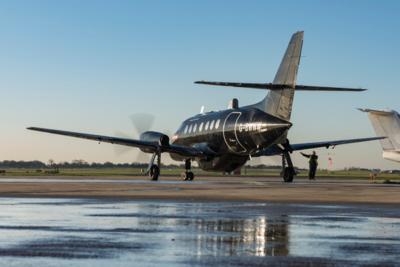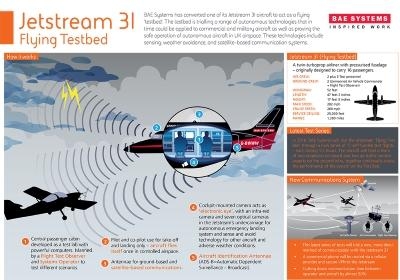Utilizing Flying Testbed To Assess How Autonomous Air Vehicles Could Be Integrated In U.K. Airspace
As part of collaborative efforts across the U.K. to assess how autonomous air vehicles could be integrated in U.K. airspace, scientists and engineers at BAE Systems have begun another tranche of ground-breaking unmanned aircraft technology trials using a Jetstream 31 as a ‘flying testbed’ which flies itself while having pilots on board who could take control at any time. The trials are being conducted from the Company’s military aircraft engineering and manufacturing facility in Warton, Lancashire, U.K.

The latest trials are self-funded by BAE Systems at a cost of around $508,000 and build on the findings of the ASTRAEA (Autonomous Systems Technology Related Airborne Evaluation and Assessment) Research and Development programme which ran from 2008-2013.
In a series of 17 flights, BAE Systems’ engineers aim to prove the capability, maturity and safe operation of autonomous air technologies controlled by a satellite-communications based link. This has the advantage of being globally available already and therefore enabling operations without the need for new infrastructure.
Also being tested are further developments of sensing technologies including aircraft and cloud avoidance using only camera input rather than radar. The results of the trials will inform the direction of the Company’s future unmanned aircraft program and the suitability of testing unmanned aircraft in the U.K.. In the near future these unmanned aircraft technologies may also be brought to market for use in commercial and military aircraft as aids to the existing crew.
The series of test flights involve a team of two engineers on-board whom together with air traffic control experts at NATS, continually assess the performance of the systems on the testbed. Flights last 1.5 hours and are flying through non-congested airspace on a route from Warton to Inverness, Scotland covering around 300 miles and normally flying at 15000 feet. A pilot and co-pilot are in control for take-off and landing – but once airborne and in controlled airspace the Jetstream flies itself. On the ground a flight test observer and a unmanned air vehicle commander - who is a fully licensed pilot for these trials – are monitoring the flights via satellite communications.

The testbed contains an aircraft identification antennae which detects other aircraft’s transponder signals as well as a cockpit mounted camera acting as an ‘electronic eye’. This links to the aircraft’s computer systems and enables the Jetstream to ‘see’ potential hazards even if no signals are being emitted. The “electronic eye” of the Jetstream can also recognize different cloud types and, if needed, plot a course that allows evasive action from challenging weather conditions.
“Our priority as always is to demonstrate the safe and effective operation of autonomous systems and together with NATS we are working towards the possibility of flying our own unmanned systems in a highly controlled environment in the U.K.," said Maureen Mccue, BAE Systems’ Head of Research and Technology for the military aircraft and information business "The trials are an exciting time and will give us technology options that could be applied to our own manned and unmanned aircraft as well potentially enabling us to take some new unmanned aircraft technologies to market.”
“NATS is always striving to find new and advanced ways to fully support the development and safe use of the ever growing market of unmanned aerial vehicles by all users, hobbyist to professional, within the UK airspace through, for example, our training courses," said Alastair Muir, Director, Prestwick, NATS. "As such we are very pleased to have supported our BAE Systems colleagues in this trial using aircraft operations of this scale and are currently working with the rest of the industry to agree how this exciting technology can be fully realised and integrated safely with conventional aviation.”
(Images provided with BAE news release)
 ANN's Daily Aero-Term (04.25.24): Airport Rotating Beacon
ANN's Daily Aero-Term (04.25.24): Airport Rotating Beacon ANN's Daily Aero-Linx (04.25.24)
ANN's Daily Aero-Linx (04.25.24) Klyde Morris (04.22.24)
Klyde Morris (04.22.24) Airborne 04.24.24: INTEGRAL E, Elixir USA, M700 RVSM
Airborne 04.24.24: INTEGRAL E, Elixir USA, M700 RVSM Airborne 04.22.24: Rotor X Worsens, Airport Fees 4 FNB?, USMC Drone Pilot
Airborne 04.22.24: Rotor X Worsens, Airport Fees 4 FNB?, USMC Drone Pilot




